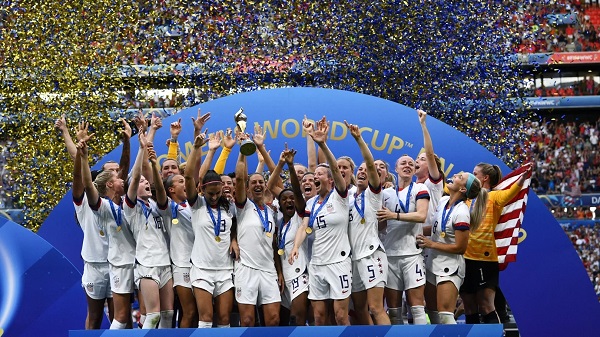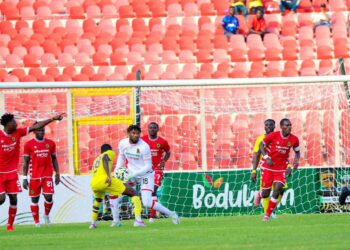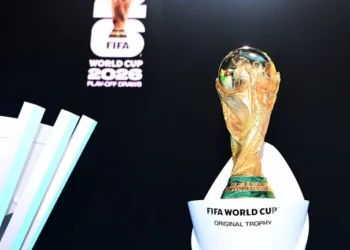The 2023 FIFA Women’s World Cup (WWC), the most anticipated female sporting event ever, kicks off on Thursday, July 20, in Australia and New Zealand.
It is the ninth edition and it is scheduled to take place from July 20 to August 20, 2023. This will be the first FIFA WWC to have more than one host nation, and also the first senior World Cup to be held across multiple confederations.
Additionally, this tournament will be the first to feature the expanded format of 32 teams from the previous 24. In 2019, FIFA unanimously voted to expand the WWC from 24 to 32 teams which will continue from the 2023 tournament onwards. The teams will compete across 64 matches at 10 different venues, making this year’s tournament the biggest to date.
The final match will take place on Sunday, August 20, 2023 at the Sydney Olympic Stadium in Australia. The United States are defending champions, having won the competition twice in 2015 and 2019. As kick-off approaches, here’s everything you need to know including the participating teams, dates, venues, prize money and players to watch as compiled by Beatrice Laryea.
Confederations
The 32 teams were selected from six different confederations across the globe. The confederations and the various slots allocated to them are as follows:
- AFC (Asia): 6 slots (including co-host Australia)
- CAF (Africa): 4 slots
- CONCACAF (North America, Central America and the Caribbean): 4 slots
- CONMEBOL (South America): 3 slots
- OFC (Oceania): 1 slot (co-host New Zealand)
- UEFA (Europe): 11 slots
- Inter-confederation play-off tournament: 3 slots

Sweden are one of the favourites
Groups
As mentioned earlier, a total of 32 teams will be participating in the tournament and the teams have been divided into eight groups of four. The group draw for the 2023 Women’s World Cup took place on October 22, 2022 in Auckland, New Zealand. Co-hosts New Zealand and Australia were automatically placed in Group A and B respectively.
- Group A:New Zealand, Norway, Philippines, Switzerland
- Group B:Australia, Republic of Ireland, Nigeria, Canada
- Group C:Spain, Costa Rica, Zambia, Japan
- Group D:England, Haiti, Denmark, China
- Group E:USA, Vietnam, Netherlands, Portugal
- Group F:France, Jamaica, Brazil, Panama
- Group G:Sweden, South Africa, Italy, Argentina
- Group H:Germany, Morocco, Colombia, South Korea

England have released their World Cup kits, both home and away
Dates
- Opening group stage matches: July 20, 2023
- Final group stage matches: August 3, 2023
- Round of 16: August 5-8, 2023
- Quarter-finals: August 11-12, 2023
- Semi-finals: August 15-16, 2023
- Third-place match: August 19, 2023
- Women’s World Cup final: August 20, 2023
Venues
The games will be held in six stadiums across Australia – in Brisbane, Adelaide, Perth, Melbourne and Sydney – and four in New Zealand – in Dunedin, Auckland, Hamilton and Wellington. The final is set to be held in Sydney’s 81,500-capacity Stadium in Australia. Below are the names of the stadiums.
- Eden Park Stadium in Auckland, New Zealand
- Sydney Football Stadium in Sydney, Australia
- Dunedin Stadium in Dunedin, New Zealand
- Melbourne Rectangular Stadium in Melbourne, Australia
- Wellington Regional Stadium in Wellington, New Zealand
- Waikato Stadium in Hamilton, New Zealand
- Brisbane Stadium in Brisbane, Australia
- Perth Rectangular Stadium in Perth, Australia
- Hindmarsh Stadium in Adelaide, Australia
- Stadium Australia in Sydney, Australia

The final will be held at Sydney’s 81,500-capacity Stadium in Australia
Prize money
FIFA has announced that prize money for the tournament will increase to $110 million. A further $31 million has been awarded to teams for preparations and $11 million to clubs for their players.
The $110 million prize money is a nearly three-fold increase on the 2019 figure and almost seven times more than in 2015, but still considerably lower than the $440 million total prize money awarded at the men’s World Cup in Qatar last year.
Women soccer players across the globe fought to receive equal pay and respect as their male counterparts, including the reigning champions, the United States, and players from Canada, France, and Spain. FIFA president Gianni Infantino said earlier this year that he hopes the 2026 men’s and 2027 women’s World Cups will have equal prize money. The following amounts will be awarded to teams depending on their progress in the tournament:
- US$1,560,000 for the group stage
- US$1,870,000 for the round of 16
- US$2,180,000 for the quarter-finals
- US$2,455,000 for fourth place
- US$2,610,000 for third place
- US$3,015,000 for runners-up
- US$4,290,000 for champions
African representation
The four African teams which qualified for the 2023 FIFA Women’s World Cup are Nigeria, South Africa, Morocco and Zambia.
Nigeria have qualified for every World Cup though they have not been able to go beyond the group stages, whilst South Africa have qualified for their second tournament in a row.
Morocco and Zambia qualified for the tournament for the first time ever, with Morocco being the first side from the Arab world, while Zambia becomes the first African side from a landlocked country to qualify for any FIFA World Cup both men’s and women’s.

Nigeria is one of the countries representing Africa
Who are favourites?
According to sports data company Gracenote, the US is the favorite to win the tournament with an 18 percent chance of success.
However, this year’s edition promises to be a tighter affair, with Sweden and Germany both given an 11 percent chance of winning by Gracenote, France a nine percent chance, and England, Spain, and Australia all an eight percent chance.
This broadly reflects the FIFA women’s rankings, which currently has the US, Germany, Sweden, England and France as the top five teams in the world.

Germany are one of the favourites
Players to watch
Australia and Chelsea forward Sam Kerr will be carrying the expectations of a nation as the star player for the Matildas and the team’s top scorer with 62 goals.
This tournament is likely to present Australia’s best chance of getting beyond the quarterfinals of a Women’s World Cup for the first time and captain Kerr is at the heart of the home nation’s grand ambitions.
For some veterans of the women’s game, this tournament will mark the end of an era. Brazilian superstar Marta, 37, is set to end her international career having scored a record 17 Women’s World Cup goals, while the USWNT’s Megan Rapinoe has also announced that she will retire after what will be her fourth and final World Cup.
At 34, Alex Morgan is also among the senior players in the US squad and is joined by young forwards Trinity Rodman, Sophia Smith and Alyssa Thompson, all looking to make an impression during their World Cup debuts.

Norwegian Ada Hegerberg will be in action at the tournament
Spain’s Alexia Putellas is a back-to-back Ballon d’Or Féminin winner – awarded to the best player in the women’s game – and earlier this year made a comeback from an anterior cruciate ligament (ACL) injury.
Two other Barcelona stars – England midfielder Keira Walsh and Nigerian striker Asisat Oshoala – will both also be crucial for their nations’ chances.
Ada Hegerberg, the inaugural Ballon d’Or Féminin winner in 2018, is part of a talented Norwegian team alongside Caroline Graham Hansen, while Wendie Renard (France), Pernille Harder (Denmark) and Alexandra Popp (Germany) are all expected to feature prominently for their countries.

Nigeria’s Asisat Oshoala is expected to shine for Africa










Discussion about this post